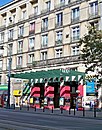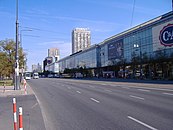Marszałkowska Street
| Marszałkowska Street | |
|---|---|
| Street in Warsaw | |
| The marszałkowska street ; View from the south of the roundabout on Rondo Dmowskiego , in the background the towers of the Blue Tower Plaza (called: Błękitny Wieżowiec ) on Plac Bankowy and the Intraco high-rise (behind) | |
| Basic data | |
| place | Warsaw |
| District | Śródmieście |
| Created | 1757 |
| Connecting roads |
Plac Bankowy Plac Unii Lubelskiej |
| Cross streets | 21 on the east side, 16 on the west side |
| use | |
| User groups | Pedestrian traffic , bicycle traffic , individual traffic , public transport |
| Technical specifications | |
| Street length | 3,580 meters |
The Ulica Marszałkowska ( ) (German: Marschallstraße ) is one of the most important north-south traffic arteries in Warsaw . It extends over a length of 3.8 kilometers through the entire inner city district and runs parallel to the former Königstrakt at a distance of around 600 meters to the west . It was the city's main shopping street until World War II , when it was largely destroyed.
history
Originally there was a path to the former village of Rakowiec, which reached to today's Ulica Sienkiewicza and formed the main street of Juridika Bielino (since 1757). The street was then known as Ulica Otwocka and Ulica Bielińska .
Until 1770 the street was extended to today's Plac Unii Lubelskiej , in the same year it was given its current name, which refers to its builder, Franciszek Bieliński , and not - as is often assumed - to Marshal Józef Piłsudski . From 1777 until the construction of the Pole Mokotowskie racecourse, horse races were also held on Marszałkowska .
The first section of the street was built on in the 18th century, but the main development did not take place until the 19th century. Johann Christian Schuch created two star-shaped squares around the turn of the century: Plac Zbawiciela with the Church of the Holy Savior ( Kościół Najświętszego Zbawiciela ) and Plac Unii Lubelskiej . After 1870, Marszałkowska was the busiest street in the city as the center of trade. At the beginning of the Second World War , the buildings were already partially destroyed, and then almost completely destroyed during the fighting during the Warsaw Uprising . During the German occupation it was called Marschallstrasse (from 1940) .
After the war, the Marszałkowska was laid out in the direction of Żoliborz and widened to two lanes. Flat bazaar buildings that were built immediately after the end of the war were demolished again in the early 1950s. In a first construction phase, the MDM district was built by 1955 , through which the Marszałkowska runs from Ulica Wilcza to Plac Unii Lubelskiej . At the same time, Plac Defilad , bordering Marszałkowska in the west and spreading out in front of the Palace of Culture, was built .
In the years 1957 to 1960, modern houses and shops were built on the street and the little existing building fabric - especially in the middle section of the street - was renovated. From 1961 to 1968 the so-called “east wall” with its shopping centers and high-rise buildings was built. After the fall of the Wall , modern office buildings were built especially in the area of the crossing Ulica Królewska , which are mainly used by banks.
Line 1 of the Warsaw Metro runs along Marszałkowska , here there are the stations “Centrum” (at the intersection with Aleje Jerozolimskie ), “Świętokrzyska” and “Ratusz Arsenał” (already at Plac Bankowy ). On the corner of Świętokrzyska , a new building for the Museum of Modern Art is to be built based on a design by Christian Kerez . Line 2 of the metro (west-east direction) also crosses line 1 (north-south) here.
Historical views
Engraving after a painting by Wojciech Gerson (1867): Marszałkowska / Świętokrzyska crossing area , view in south direction
Photo (November 1939): Buildings destroyed during the attack on Warsaw at the Marszałkowska / Aleje Jerozolimskie intersection
Side streets and squares
The Marszałkowska runs largely straight, just between the Plac Bankowy and Ulica Królewska it comes to the former Żelazna Brama and the Saxon Garden in a slight curve education. At Plac Bankowy , Marszałkowska in the north leads into Ulica Generała Władysława Andersa and at Plac Unii Lubelskiej in the south into Ulica Puławska (or - as a one-way street system - already at Plac Konstytucji into Ulica Waryńskiego ).
East side of the street (south to north)
- Plac Unii Lubelskiej
- Ulica Emila Zoli
- Litewska Street
- Aleja Armii Ludowej (underpass)
- Plac Zbawiciela
- Plac Konstytucji
- Koszykowa Street
- Piękna Street
- Ulica Wilcza
- Ulica księdza Jana Skorupki
- Ulica Hoża
- Wspólna Street
- Ulica Żurawia
- Nowogrodzka Street
- Rondo Romana Dmowskiego
- Aleje Jerozolimskie
- Widok ulica
- Ulica Złota (underpass)
- Henryka Sienkiewicza Street
- Ulica Świętokrzyska
- Rysia Street
- Ulica Królewska
- Senatorska Street
- Plac Bankowy
The neo-Gothic pigeon house building from 1898 at Marszałkowska 72
Novotel Hotel am Rondo, formerly the Forum Hotel
PKO-Rotunda on Rondo Dmowskiego
West side of the road (from south to north)
- Plac Unii Lubelskiej
- Ulica Oleandrów
- Aleja Armii Ludowej (underpass)
- Plac Zbawiciela
- Plac Konstytucji
- Koszykowa Street
- Ulica Wilcza
- Ulica Hoża
- Wspólna Street
- Ulica Żurawia
- Nowogrodzka Street
- Rondo Romana Dmowskiego
- Ulica Złota (underpass)
- Ulica Świętokrzyska
- Ulica Królewska
- Elektoralna Street
- Plac Bankowy
Former Stock Exchange and National Bank on Plac Bankowy
Individual evidence
- ↑ according to Martin Ludwig Schlesinger, Langenscheidts keyword books. Land and people in Russia , 2nd edition, Langenscheidtsche Verlagsbuchhandlung, 1909, p. 518 f.
- ↑ according to Discover Małgorzata Danecka, Thorsten Hoppe, Warsaw. Tours through the Polish capital , Trescher Verlag, ISBN 978-3-89794-116-8 , Berlin 2008 p. 23.
- ↑ according to Tomasz Szarota, Warsaw under the swastika. Life and everyday life in occupied Warsaw October 1 , 1939 to July 31 , 1944 , volume 77472 from the Schöningh collection on past and present , ISBN 978-3-50677-472-9 , Schöningh, 1985, p. 25.
- ↑ In the 1950s, the monumental apartment block was home to one of the city's most famous cafes, the "Świtezianka". Artists and journalists from the nearby publishers of the newspapers Życie Warszawy and Stolica met here . Frequent guests were the cartoonist Julian Żebrowski and the pre-war reporters Jacek Wołowski and Andrzej Tewiaszew. The writer Marek Nowakowski thematized the café in his work "Nekropolis", gem. Jerzy S. Majewski , Propagandowy MDM in Gazeta.pl (Warszawa) of June 2, 2008 (Polish).
literature
- Julius A. Chroscicki and Andrzej Rottermund: Architectural Atlas of Warsaw. 1st edition, Arkady, Warsaw 1978, p. 94 ff.
- Werner Huber: Warsaw - Phoenix from the ashes. An architectural city guide , Verlag Böhlau, ISBN 3-412-14105-4 , Cologne 2005, p. 127 ff.
- Janina Rukowska: Travel guide to Warsaw and surroundings. 3rd edition, Sport i Turystyka, ISBN 83-217-2380-2 , Warsaw 1982, p. 100.
- Reinhold Vetter: Warszawa / Warsaw . in: Poland. History, art and landscape of an ancient European cultural nation . DuMont Art Travel Guide, 3rd edition, DuMont Buchverlag, ISBN 3-7701-2023-X , Cologne 1991, p. 168 ff.
Web links
- Information with many historical views at Warszawa1939.pl (Polish)
- Warsaw Wiki (Polish)
- More historical views at Przewodnik po Warszawie (Polish)
















